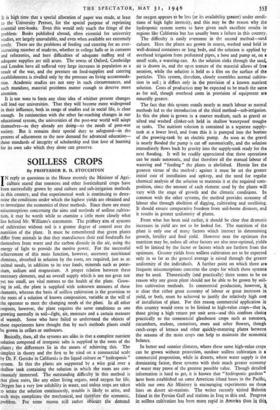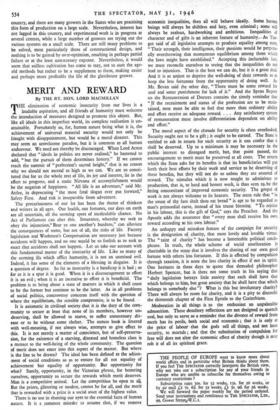SOILLESS CROPS
By PROFESSOR R. H. STOUGHTON N reply to questions in the House recently the Minister of Agri- ' culture stated that tomatoes and other horticultural crops have teen successfully grown by sand culture and sub-irrigation methods in this country, and that experimental work is continuing to deter- mine the conditions under which the highest yields are obtained and to investigate the economics of these methods. Since there are many misconceptions concerning the aims and methods of soilless cultiva- tion, it may be worth while to examine a little more closely what lies behind Mr. Williams's statements. The prirtiary aim of systems of cultivation without soil is a greater degree of control over the nutrition of the plant. It must be remembered that green plants differ from animals in that they manufacture their real foodstuffs for themselves from water and the carbon dioxide in the air, using the energy of light to provide the motive power. For the successful achievement of this main function, however, accessory nutritional elements, absorbed in solution by the roots, are required, just as an animal needs, in addition to its true foods, minerals such as potas- sium, sodium and magnesium. A proper relation between these necessary elements, and an overall supply which is not too great nor yet too small, are vital matters to the health of the plant. Grow- ing in soil, the plant is supplied with unknown amounts of these elements, whereas the basis of soilless cultivation is the provision to the roots of a solution of known composition, variable at the will of the operator to meet the changing needs of the plant. In all other respects, however, the plant requires the same conditions as one growing normally in soil—light, air, moisture and a certain measure of warmth. Some who have failed to understand the objects of these experiments have thought that by such methods plants could be grown in cellars or outhouses.
Basically, then, all the systems are alike in that a complete nutrient solution composed of inorganic salts is supplied to the roots of the plants ; the differences lie in the means of achieving this. The simplest in theory and the first to be tried on a commercial scale by Dr. F. Gericke in California is the liquid culture or " hydroponic " system. In this the plants are supported by a wire grid over a shallow tank containing the solution in which the roots are con- tinuously immersed. The outstanding difficulty in this method is that plant roots, like any other living organs, need oxygen for life. Oxygen has a very low solubility in water, and unless steps are taken to aerate the solution continuously, trouble is likely to arise, and such steps complicate the mechanical, and therefore the economic, problem. For some reason still rather obscure the demand for oxygen appears to be less (or its availability greater) under condi- tions of high light intensity, and this may be the reason why the hydroponic system seems to have given such excellent results in regions like California but has usually been a failure in this country.
The difficulty is easily criercome in the second method—sand culture. Here the plants are grown in coarse, washed sand held in well-drained containers or long beds, and the solution is applied by overhead irrigation from perforated pipes, a hose and pump or, on small scale, a watering-can. As the solution sinks through the sand, air is drawn in, and the open texture of the material allows of free aeration, while the solution is held as a film on the surface of the particles. This system, therefore, closely resembles normal cultiva- tion in soil ; it differs only in the provision of a known nutrient solution. Costs of production may be expected to be much the same as for soil, though overhead costs in provision of equipment are naturally greater.
The fact that this system entails nearly as much labour as normal methods led to the introduction of the third method—sub-irrigation. In this the plant is grown in a coarser medium, such as gravel or sifted and washed clinker-ash held in shallow Waterproof troughs or tanks. The nutrient solution is contained in a separate supply- tank at a lower level, and from this it is pumped into the bottom of the growing-tank by an electric pump. As soon as the gravel is nearly flooded the pump is cut off automatically, and the solution immediately flows back by gravity into the supply-tank ready for the next flooding. It will be readily appreciated that these operations can be made automatic, and that therefore all the manual labour of watering and " feeding " the plants is abolished. Herein lies the greatest virtue of the method : against it must be set the greater initial cost of installation and upkeep, and the need for regular chemical analysis of the solution to maintain it at the required com- position, since the amount of each element used by the plants will vary with the stage of growth and the climatic conditions. In common with the other systems, the method provides economy of labour also through abolition of digging, cultivating and sterilising. It should ensure comparative freedom from soil-borne diseases, and it results in greater uniformity of plants.
From what has been said earlier, it should be clear that dramatic increases in yield are not to be looked for. The nutrition of the plant is only one of many factors which interact in determining growth, fertility and final yield. However near the optimum the nutrition may be, unless all other factors are also near-optimal, yields will be limited by the factor or factors which are farthest from the optimum. Greater yields from soilless cultivation are to be expected only in so far as the general average is raised through the greater uniformity of the individuals. A further point on which there are frequent misconceptions concerns the crops for which these systems may be used. Theoretically (and practically) there seems to be no reason why any green plant should not be able to be grown by soil- less cultivation methods. In commercial production, however, 4 is clear that either great economy of labour or great increases in yield, or both, must be achieved to justify the relatively high cost of installation of plant. For this reason commercial application in this country would seem to be limited to high-value crops—that is, those giving a high •return per unit area—and this confines choice practically to the commercial glasshouse crops such as tomatoes, cucumbers, melons, carnations, roses and other flowers, though catch-crops of lettuce and other quickly-maturing plants between the seasons of the main crops can help to maintain the economic balance.
In hotter and sunnier climates, where these same high-value crops can be grown without protection, outdoor soilless cultivation is I commercial proposition, while in deserts, where water supply is the dominating factor, these systems with their much greater economy of water may prove of the greatest possible value. Though detailed information is hard to get, it is known that "hydroponic gardens" have been established on some American island bases in the Pacific, while our own Air Ministry is encouraging experiments on these lines on desert air-stations. The writer recently visited Bahrein Island in the Persian Gulf and stations in Iraq to this end. Progress in soilless cultivation hag been more rapid in America than in thi%
country, and there are many growers in the States who are practising this form of production on a large scale. Nevertheless, interest has not lagged in this country, and experimental work is in progress at several centres, while a large number of growers are trying out the various systems on a small scale. There are still many problems to be solved, most particularly those of constructional design, and nothing is to be gained by over-optimism, resulting in perhaps partial failure or at the least unnecessary expense. Nevertheless, it would teem that soilless cultivation has come to stay, not to oust the age- old methods but rather to be a supplement to them, making easier and perhaps more profitable the life of the glasshouse grower.































 Previous page
Previous page